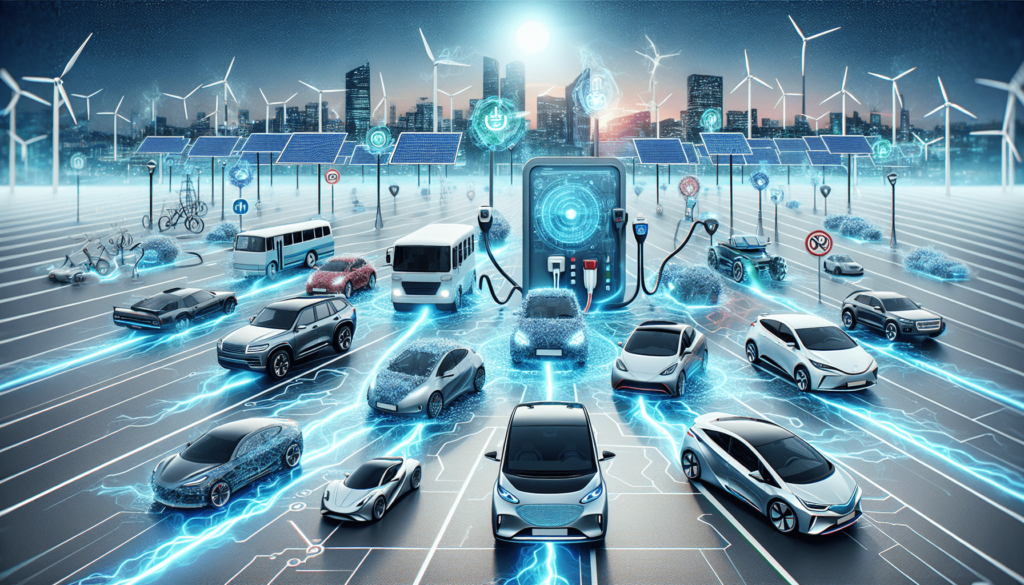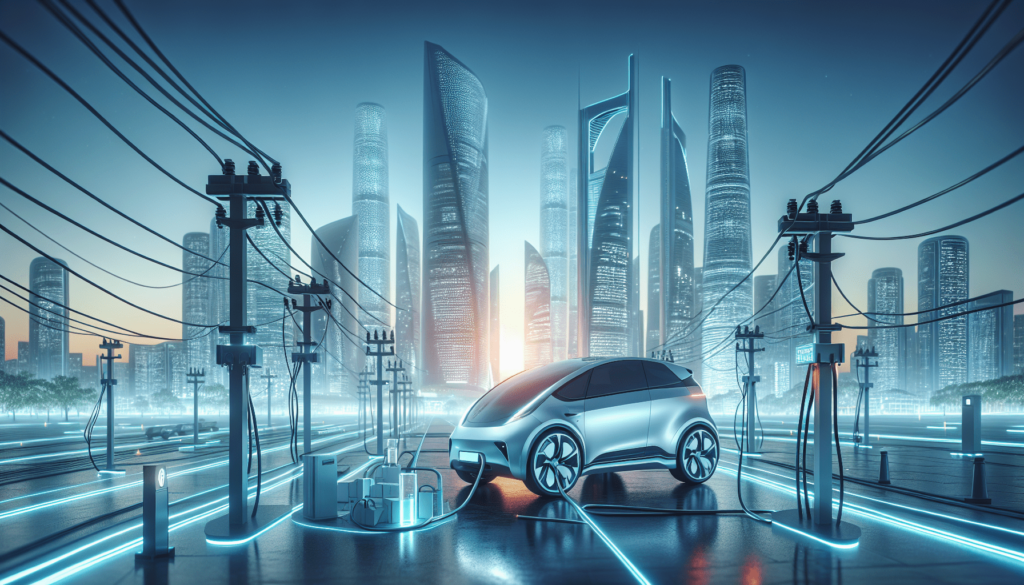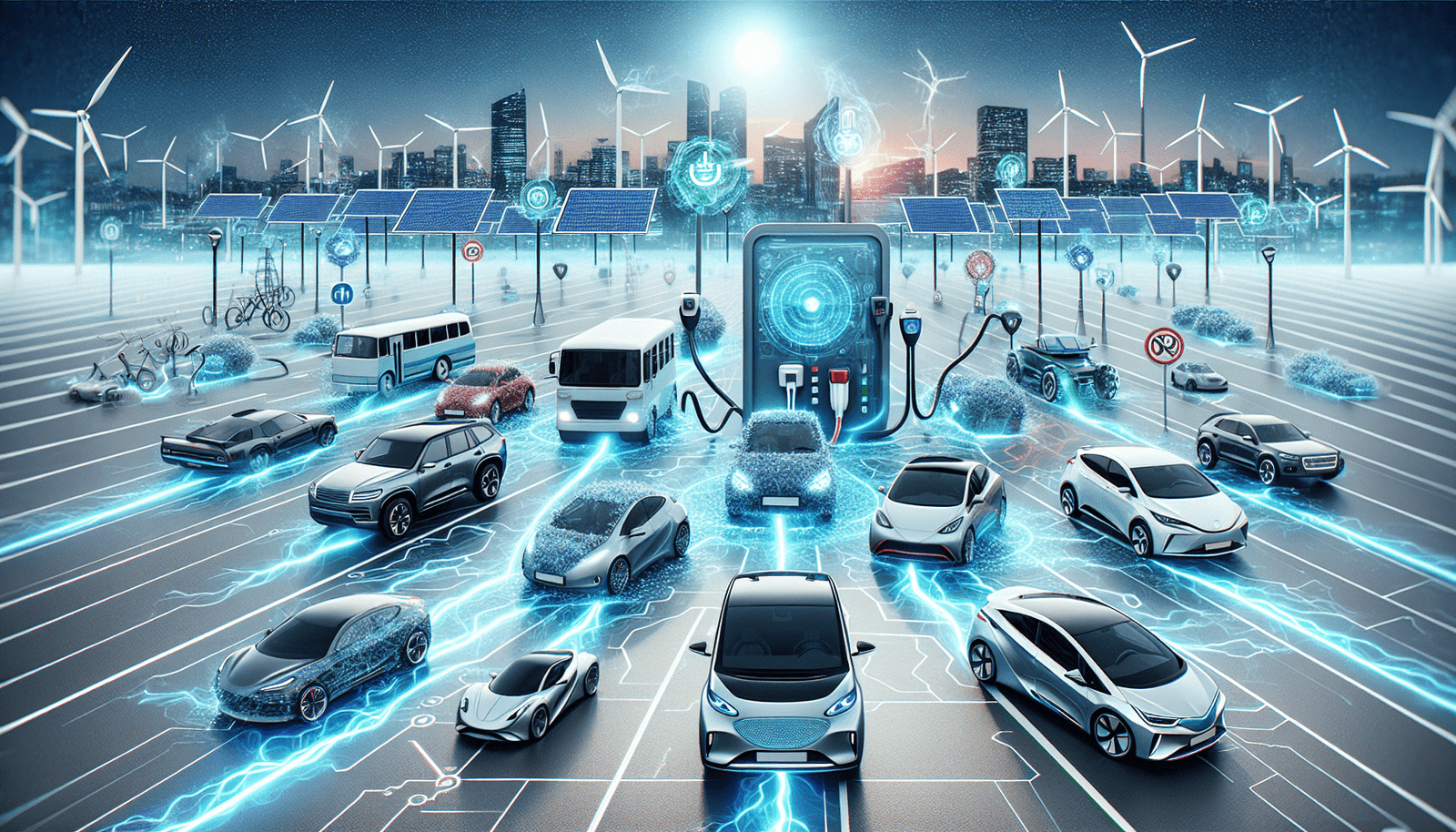Imagine a future where your electric vehicle not only transports you efficiently, but also becomes an energy resource for your home and the surrounding grid. This is the promise of vehicle-to-grid (V2G) technology, a groundbreaking innovation that allows electric vehicles to seamlessly transfer energy back to the grid when not in use. In recent years, the advancements in V2G technology have been nothing short of remarkable, with improved efficiency, enhanced smart grid integration, and increased support from governments and industries alike. In this article, we will explore the latest developments in V2G technology and the potential it holds for revolutionizing the way we power our homes and cities.
1. Overview of Vehicle-to-Grid (V2G) Technology
Definition of V2G
Vehicle-to-Grid (V2G) technology refers to the connection and bi-directional flow of power between electric vehicles (EVs) and the electrical grid. It enables EVs to not only consume electricity from the grid but also feed electricity back into the grid, turning them into mobile energy resources.
How V2G works
V2G technology enables EV owners to not only charge their vehicles but also discharge energy stored in their batteries back into the grid when needed. By utilizing bidirectional charging technology, energy can flow both ways between the EV and the grid, allowing the grid to draw power from the EV’s battery during peak demand and supply power back to the EV during times of low demand.
Benefits of V2G
V2G technology provides numerous benefits to both EV owners and the overall energy system. For EV owners, it creates opportunities to not only reduce the costs associated with charging their vehicles but also generate revenue by utilizing their EVs as energy assets. Additionally, V2G technology enhances the overall stability and reliability of the electrical grid by balancing energy supply and demand, reducing the need for expensive grid infrastructure upgrades, and facilitating the integration of renewable energy sources.
2. Advancements in V2G Infrastructure
Smart Charging Stations
One of the key advancements in V2G infrastructure is the development of smart charging stations. These stations not only provide a reliable and efficient charging experience for EV owners but also enable grid operators to manage and optimize the charging and discharging of EVs. Equipped with advanced communication capabilities, these smart charging stations can receive real-time grid signals and adjust the charging or discharging cycles of EVs accordingly, thereby maximizing the benefits of V2G technology.
Bidirectional Charging Technology
Another significant advancement in V2G infrastructure is the development of bidirectional charging technology. By allowing EVs to not only receive energy from the grid but also send energy back, bidirectional charging maximizes the flexibility and potential of V2G applications. This technology enables EVs to function as both energy consumers and suppliers, turning them into mobile energy storage units that can help stabilize the grid, optimize energy usage, and support the integration of renewable energy sources.
Grid Integration Solutions
Advancements in V2G infrastructure also include the development of grid integration solutions. These solutions focus on the seamless integration of EVs into the existing electrical grid infrastructure. By implementing intelligent grid management systems, grid operators can effectively monitor and control the flow of energy between EVs and the grid. This ensures that the energy flow is balanced and optimized, minimizing the impact on the grid and maximizing the benefits of V2G technology.

3. V2G in the Electric Vehicle (EV) Market
Increasing EV Adoption
As the global shift towards sustainable transportation continues, the adoption of EVs is rapidly increasing. This surge in EV adoption has created a significant opportunity for the widespread implementation of V2G technology. With a larger fleet of EVs on the road, there is a greater potential for V2G applications, leading to enhanced grid stability, increased renewable energy integration, and improved overall energy management.
V2G-enabled EV Models
Major automakers are recognizing the potential of V2G technology and are integrating it into their EV models. These V2G-enabled EVs are designed with bidirectional charging capabilities, allowing them to interact seamlessly with V2G infrastructure. This integration opens up new possibilities for EV owners to actively participate in energy markets, monetize their EVs’ battery capacity, and contribute to a more sustainable energy future.
Impact on EV Sales
The availability of V2G technology in EVs has the potential to positively impact EV sales. With the added benefit of being able to earn revenue by participating in V2G programs, potential EV buyers have a greater incentive to choose an EV over a traditional internal combustion engine vehicle. This not only accelerates the transition towards greener transportation but also strengthens the business case for investing in V2G infrastructure and deploying more charging stations.
4. Integration of Renewable Energy Sources
Renewable Energy Generation
Integration of renewable energy sources into the electrical grid is a key focus in the pursuit of a sustainable and low-carbon future. V2G technology plays a crucial role in this integration by enabling EVs to act as distributed energy resources. With the ability to store excess renewable energy during periods of high generation and discharge it back into the grid during times of low generation, V2G technology ensures a more efficient utilization of renewable energy resources.
V2G and Solar Energy
Solar energy, as a widely adopted renewable energy source, can greatly benefit from V2G technology. During peak solar generation periods, when the grid may not have the capacity to fully absorb the excess energy, V2G-enabled EVs can help alleviate the strain on the grid by storing the surplus energy. Conversely, during times of low solar generation, the energy stored in EV batteries can be discharged back into the grid, reducing the reliance on fossil fuel-based power plants and promoting a cleaner and more sustainable energy system.
V2G and Wind Energy
Similar to solar energy, wind energy can also benefit from V2G technology. Wind power generation is intermittent, with fluctuations in wind speed and direction. V2G-enabled EVs can assist in balancing the intermittent nature of wind energy generation by absorbing excess energy during periods of high wind power output and releasing it during periods of low output. By integrating V2G technology with wind energy, a more reliable and stable energy supply can be achieved, reducing the need for excess curtailment and maximizing the utilization of renewable energy resources.

5. Grid Stabilization and Long-term Energy Storage
Supporting Grid Stability
V2G technology offers significant potential for supporting grid stability. By continuously monitoring and adjusting the energy flow between EVs and the grid, V2G-enabled systems can help balance the demand and supply of electricity. During times of high demand, when the grid is under stress, EVs can discharge their stored energy to support the grid. Conversely, during low-demand periods, EVs can charge, utilizing the excess capacity of the grid. This bidirectional power flow helps to stabilize the grid, reduce strain on the electrical infrastructure, and ensure a reliable and resilient energy system.
Peak Power Management
V2G technology also has the ability to effectively manage peak power demand. During peak load periods, such as hot summer days when air conditioning units are running at full capacity, V2G-enabled EVs can provide additional power to the grid. By utilizing the aggregated battery capacity of a large number of EVs, V2G systems can alleviate the strain on the grid, reducing the need for expensive infrastructure upgrades and promoting the efficient use of energy resources.
V2G as a Long-term Energy Storage Solution
V2G technology has the potential to serve as a long-term energy storage solution. With a rapidly increasing number of EVs on the road, the aggregated battery capacity can be substantial. By utilizing this vast storage capacity, excess energy generated from renewable sources can be stored in EV batteries during off-peak periods and released back to the grid during high-demand periods. This long-term energy storage capability enhances the overall stability of the grid, supports the integration of renewable energy, and reduces the need for traditional fossil fuel-based power plants.
6. Policy and Regulatory Framework for V2G
Government Initiatives and Incentives
Governments around the world are recognizing the importance of V2G technology and are implementing initiatives and incentives to promote its development and adoption. These include financial incentives, tax credits, grants, and research funding to support the deployment of V2G infrastructure and V2G-enabled EVs. Additionally, governments are forming partnerships with utilities, automakers, and other stakeholders to establish regulatory frameworks that enable the implementation and expansion of V2G technology.
Regulatory Challenges
Despite the benefits and potential of V2G technology, there are regulatory challenges that need to be addressed. These challenges include ensuring interoperability standards between different V2G systems, establishing rules and regulations for grid operators and EV owners participating in V2G programs, and addressing liability and safety concerns related to bidirectional energy flow. Clear and consistent regulations are necessary to provide a supportive environment for the deployment and integration of V2G technology.
Standardization Efforts
Standardization efforts play a critical role in the success of V2G technology. These efforts aim to establish common technical and communication standards for V2G systems to ensure interoperability, compatibility, and safety. Standardization enables seamless integration of V2G-enabled EVs with various charging stations and grid infrastructure. International organizations, standard development organizations, and industry collaborations are actively working together to develop and implement these standards, facilitating the widespread adoption and scalability of V2G technology.
7. Challenges and Barriers to V2G Implementation
Infrastructure Limitations
The implementation of V2G technology faces infrastructure limitations. The availability and accessibility of charging stations, especially V2G-capable stations, are crucial for the scalability and widespread adoption of V2G technology. Additionally, retrofitting existing charging infrastructure with V2G capabilities can be costly and challenging. Adequate investment in charging infrastructure and the deployment of V2G-enabled smart charging stations are necessary to overcome these infrastructure limitations.
Technological Hurdles
Technological challenges also exist in the implementation of V2G technology. These challenges include developing efficient bidirectional charging systems, ensuring seamless communication between EVs and the grid, and managing complex energy flow algorithms. Furthermore, the performance, reliability, and lifetime of EV batteries need to be optimized to withstand the demands of frequent charging and discharging cycles. Continued research, innovation, and collaboration between automakers, energy companies, and technology providers are essential to overcome these technological hurdles.
Business Models and Revenue Generation
The establishment of viable business models and revenue streams is crucial for the wider adoption of V2G technology. The ability of EV owners to monetize their participation in V2G programs and compensate for potential wear on their EV batteries is essential. Additionally, the creation of market mechanisms that accurately value the services provided by V2G-enabled EVs, such as grid support and demand response, is critical for attracting investment and incentivizing participation. Collaborations between various stakeholders, including utilities, grid operators, and EV owners, are necessary to develop sustainable business models and revenue generation strategies.
8. V2G Pilot Projects and Commercial Deployments
Pilot Projects around the World
V2G technology has been extensively tested and demonstrated through numerous pilot projects across the globe. These projects involve collaboration between automakers, utilities, and research institutions to evaluate the technical feasibility, economic viability, and market potential of V2G technology. They have provided valuable insights into the advantages, limitations, and challenges of implementing V2G systems, paving the way for commercial deployments.
Commercial V2G Integration
As the technology matures and the business case for V2G strengthens, commercial deployments of V2G systems are emerging. Utility companies and automakers are partnering to establish V2G programs and platforms that enable the participation of EV owners in demand response programs, energy trading, and grid support services. These commercial deployments are essential for scaling up V2G technology and integrating it into the mainstream energy ecosystem.
Success Stories and Lessons Learned
Success stories from V2G pilot projects and commercial deployments provide valuable insights and lessons learned for the future development and implementation of V2G technology. These stories showcase the positive impacts of V2G technology on grid stability, renewable energy integration, and the economic benefits for EV owners. Analyzing and disseminating the outcomes of these success stories promotes knowledge sharing and further accelerates the adoption of V2G technology.
9. Future Outlook of V2G Technology
Emerging V2G Applications
V2G technology is continuously evolving, leading to the emergence of new applications and use cases. These include V2G-enabled vehicle fleets for commercial operations, microgrid integration using V2G systems, and V2G as a part of smart city initiatives. With the advancement of technology and the expansion of V2G infrastructure, the potential applications of V2G technology are expected to increase, further contributing to a sustainable and resilient energy future.
Advanced V2G Control Techniques
The future of V2G technology lies in the development of advanced control techniques. These techniques focus on optimizing the energy management and power flow between EVs and the grid. Through advanced algorithms, artificial intelligence, and machine learning, V2G systems can intelligently predict and respond to grid conditions, seamlessly adapt to user preferences, and maximize the value and benefits of V2G technology. Continued research and development in control techniques will further enhance the performance, efficiency, and reliability of V2G systems.
Potential Impact on Energy Markets
The widespread adoption and integration of V2G technology have the potential to transform energy markets. With a large fleet of V2G-enabled EVs acting as distributed energy resources, the dynamics of energy supply and demand will change. V2G systems can provide additional capacity during periods of high demand, potentially reducing the reliance on peaker plants and expensive grid infrastructure. Additionally, V2G can enable new energy trading models, allowing EV owners to buy and sell electricity based on market conditions, creating a more dynamic and efficient energy market.
10. Conclusion
Summary of V2G Developments
Vehicle-to-Grid (V2G) technology has witnessed significant advancements in recent years. The development of smart charging stations, bidirectional charging technology, and grid integration solutions has paved the way for the widespread implementation of V2G infrastructure. These developments, coupled with the increasing adoption of EVs and the integration of renewable energy sources, have created new opportunities and possibilities for V2G applications.
Anticipated Growth and Importance of V2G
The future growth of V2G technology is promising. With the ongoing global transition towards sustainable transportation and the increasing need to integrate renewable energy sources into the grid, V2G technology is expected to play a crucial role. Its ability to support grid stability, provide long-term energy storage, and optimize energy usage positions V2G as a key solution for a sustainable and resilient energy future. The anticipated growth of V2G technology emphasizes its importance in achieving a cleaner, greener, and more efficient energy ecosystem.

